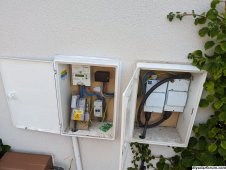CaptainHam
New Member
Not DIY, I’m just trying to get my head around a planned install and want to ensure the installer does the right thing, but figured there would be a knowledgeable bunch in this subforum. Sorry in advance for wrong terms being used and general naivety…
From our main 100A feed, we have a split…the original supply (box on the right) feeds the main CU in the house, i.e., supplies basically everything in the house (which in turn supplies a tiny CU in garage for lights and sockets, but we can forget about that).
The box on the left is a retrofit switch which supplies an AC unit directly, and also supplies a second, larger CU in the garage for an EV charger and a hot tub.

The gubbins in the left cabinet shows where the split happens, I believe it’s called a Hendy block to split the tails, which was put in as part of the retrofit.

The solar kit (inverter and battery) will be installed in the garage, and ultimately using the cable connected to the “left switch” from first pic (as in, same cable that currently feeds EV charger and hot tub).
My question relates to how the solar/battery supply will feed the main CU (linked to “right switch”), either during the day (solar supply), night (battery supply), or during a power outage (if I activate the manual EPS switch that I’ve requested).
Will the magic simply happen and the power will find its way to where it is needed, and therefore I’m worrying about nothing…or is this a very complex setup and require lots of additional faffing to somehow link both halves / both the original main CU and the retrofit CU.
I definitely want to ensure that I can charge EV from solar during the day (via retrofit CU in garage) as well as power the house and the AC unit).
Hope that makes some sort of sense…
From our main 100A feed, we have a split…the original supply (box on the right) feeds the main CU in the house, i.e., supplies basically everything in the house (which in turn supplies a tiny CU in garage for lights and sockets, but we can forget about that).
The box on the left is a retrofit switch which supplies an AC unit directly, and also supplies a second, larger CU in the garage for an EV charger and a hot tub.

The gubbins in the left cabinet shows where the split happens, I believe it’s called a Hendy block to split the tails, which was put in as part of the retrofit.

The solar kit (inverter and battery) will be installed in the garage, and ultimately using the cable connected to the “left switch” from first pic (as in, same cable that currently feeds EV charger and hot tub).
My question relates to how the solar/battery supply will feed the main CU (linked to “right switch”), either during the day (solar supply), night (battery supply), or during a power outage (if I activate the manual EPS switch that I’ve requested).
Will the magic simply happen and the power will find its way to where it is needed, and therefore I’m worrying about nothing…or is this a very complex setup and require lots of additional faffing to somehow link both halves / both the original main CU and the retrofit CU.
I definitely want to ensure that I can charge EV from solar during the day (via retrofit CU in garage) as well as power the house and the AC unit).
Hope that makes some sort of sense…


